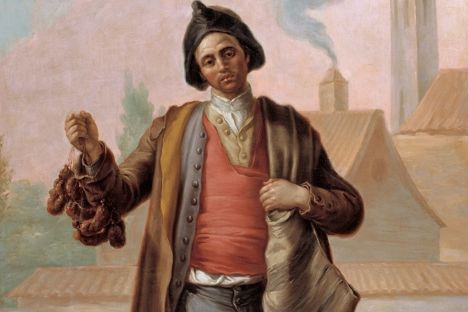
Chorizo through the ages
How much of an impact could a simple cured sausage have on the history and culture of a country? More than you might think, as it turns out. Take a look at how chorizo has weaved itself into the cultural tapestry of Spain over the centuries and gain a newfound respect for the beloved delicacy.
Chorizo through the ages
How much of an impact could a simple cured sausage have on the history and culture of a country? More than you might think, as it turns out. Take a look at how chorizo has weaved itself into the cultural tapestry of Spain over the centuries and gain a newfound respect for the beloved delicacy.
Take some fresh meat; mix it with plenty of salt; leave it hanging around for a while and bingo – you’ve got a cured sausage. While this sounds pretty basic (and very dangerous with today’s health and safety standards!), this is essentially how meat is cured and made into charcuterie. It’s a technique that’s been around for millennia, utilised by civilisations the world over to preserve meat for the days, weeks and months ahead. Today, there are thousands of cured meats documented from around the world, many of which fall into the category of 'sausages'. At their core, sausages are made with minced or finely chopped meat that’s then salted and stuffed into casings (usually an intestine or internal organ lining of some kind) with all manner of other ingredients and flavourings, then left to mature or eaten fresh. When you write it out like that it doesn’t sound like the most appealing food in the world, but as we all know – nothing really beats a top-quality sausage.
The first written evidence of sausage-making dates back to Ancient Greece (‘morcilla’ (blood sausage) was mentioned in Homer’s The Odyssey), and since then (and quite likely before then, too) cultures from every corner of the globe have been producing and enjoying sausages in all sorts of shapes and forms. In Spain, however, the one sausage to rule them all has to be chorizo – the red-hued, garlicky, spiced and often smoked pork sausage that imbues its flavourful oil into every dish it touches. But it’s evolved and transformed quite a bit over the centuries to become the sausage we know and love today.
Originally, all Spanish sausages – chorizo or otherwise – were closely associated with the country’s agricultural calendar. In October, farmers would feed the pigs they’d reared over the summer and fatten them up, ready for slaughtering in November. St Martin’s Day on 11 November is traditionally when the matanza (‘slaughter’) would occur, after which every single part of the pig would be butchered, prepared and preserved – a tradition which still exists in many rural Spanish regions today. As there were cold months ahead and not much fresh produce to go around, most of the pig would be cured, so there was something to keep the farmers and their families nourished over the winter. Blood would be made into morcilla; whole legs would be cured and made into hams; and all the trimmings and off-cuts would be finely chopped down into mince to become sausages – some of which eventually became known as chorizo.
The first Spanish sausage to be mentioned in the Real Academia de la Lengua (Spain’s answer to the Oxford English Dictionary) was a chorizo – described as ‘a short piece of gut, filled with chopped, seasoned meat, normally pork, that is usually smoke-cured’. These chorizo, however, would be unrecognisable to us – they were often black, grey or off-white rather than the glowing red that sets them apart in the shops today. That’s because pimènton (smoked paprika) was only introduced to Europe after its discovery in the New World in the sixteenth century. It took a good few decades for this spice to find its way into the rustic charcuterie of Spanish farmers, but eventually it did – along with black pepper – and chorizo as we know it today was born.
Whilst chorizo sausages were prepared by peasant farmers, they remained a luxury of the wealthy, especially once exotic pimènton and pepper were introduced into the recipes. However, they were still lower in the pecking order when compared to game or whole cured ham – that is, until Charles IV developed a taste for them. The story goes that he was out hunting when a chorizo-maker offered him a taste of his produce. The king loved the flavour so much that he instantly appointed the man as the royal chorizo provider – a moment that was captured in a tapestry by Francisco Bayeu called The Choricero Jose Rico, Candelario (pictured above).
It wasn’t until the nineteenth century, when industrialisation meant food production increased massively, that chorizo went from being a luxury to a more common everyday foodstuff, and it’s only in the past few decades that it’s become a readily available sausage in the likes of the UK. Of course, there are many different varieties of chorizo to choose from – beyond the dulce (sweet) and picante (spicy) varieties, almost every region of Spain has its own methods and ingredients that go into a particular chorizo. There’s also Mexican chorizo, which is fresher and unaged, and countless more varieties created in countries that were once colonised by the Spanish and Portuguese – from Latin America to Goa in India. However, Spanish chorizo is the one that has really taken the world by storm, and it’s the one we reach for more than any other. Just like Charles IV before us, we can’t get enough of it – if only we had the power to appoint our own royal chorizo providers!


